My opening keynote at the most recent MarTech conference was titled, “The New, New Rules of Marketing (Operations).” It was an iteration on ideas of the 4 forces of marketing operations & technology that I first wrote about a couple of months ago.
In agile fashion, I’ve continued to revise this model and its presentation based on feedback. Two tweaks I think are helpful. First, framing this as five forces, not four, to include “change.” And second, labeling the rules of these five forces as “The New Rules of Marketing Technology & Operations.”
They’re applicable to marketing more broadly, but I beleive this framework is most relevant to marketing operations and technology leaders and the evolution of this new hybrid profession.
5 Rules for Marketing Technology & Operations Leadership
Marketing technology and operations have become a pillar capability of the modern marketing organization. Leaders of this function sit between two layers of marketing: high-level marketing strategy and vision above, and on-the-ground marketing and customer experience delivery below.
Sandwiched between these two layers is an opportunity to shape marketing’s capabilities and culture to your competitive advantage in the customer experience economy. While marketing technology — what we affectionately call “martech” — helped create this opportunity, it also spawned a gaggle of complex challenges.
After watching hundreds of marketing executives wrangle with these new dynamics, I have developed a framework that I think captures the essence of this role, explains the forces it must manage, and offers some guidance in how to manage them: The 5 Forces of Marketing Technology & Operations.
In bare-bones grid form, it looks like this (hang in, I’ll explain the grid in a minute):
The goal of this grid isn’t to pick a spot and aim for it. “Our company should be there.” It’s exactly the opposite: you want to make sure your organization is covering the entire grid. Any gaps on your grid are weak points to be strengthened.
So we can recast this grid as five rules of marketing technology and operations leadership:
- Centralize everything you can.
- Automate everything you can.
- Decentralize everything you can.
- Humanize everything you can.
- Embrace continuous change.
Your first reaction might be, “Hey, some of those rules are contradictory!”
If so, you’re in good company. Augie Ray, a leading customer experience analyst at Gartner, chided me, “You just put ‘Automate everything you can’ and ‘Humanize everything you can’ two places from each other. I can’t decide if that’s funny or sad.”
(I’m actually a big fan of Augie’s.)
But one could quip back the F. Scott Fitzgerald quote:
“The test of a first-rate intelligence is the ability to hold two opposed ideas in mind at the same time and still retain the ability to function.”
In fact, this gets right to the heart of why marketing technology and operations leadership is challenging: we are being asked to balance powerful, opposing forces — and simultaneously be successful on both ends of the spectrum. Better centralization and better decentralization. More automated and more humanized.
Sounds like a riddle, wrapped in a mystery, inside an enigma. But actually, it’s not.
Martech Paradox #1: Centralize & Decentralize
Let’s start with centralize and decentralize. Organizations have been wrestling with this trade-off for ages: more power and control at the center of the organization (e.g., corporate) versus more freedom and flexibility at the edge (e.g., the field, the geos, the lines of business).
Such a tug-of-war often alternates back-and-forth over time, in a wave-like function.
Leaders on the edge push the boundaries to achieve their goals on the ground — until such decentralization starts to threaten the unity or overall efficiency of the whole. Then the center pulls more control back in. Until the edge chafes at that yoke and creatively finds new ways around those centralized constraints that they find too restrictive, so they can get stuff done.
We want both. We want the efficiency and brand cohesion of centralization — it gives us scale. Yet we also want the fast adaptability and creative experimentation of decentralization — it gives us agility.
But if this is a trade-off, a balancing act between centralization and decentralization, can you improve both simultaneously? That seems like a paradox.
Marketing technology, at its best, breaks this tyranny-of-or paradox. Here are a few examples:
A centralized CMS provides brand-standard templates, with established guardrails that prevent content creators from accidentally publishing bad or broken HTML. Yet it empowers a much wider set of individuals on the edge of the organization to quickly and safely create campaign landing pages and blog posts without being bogged down by a backlogged central production unit. It’s better centralization and better decentralization.
Customer data platforms (CDPs), all the rage these days, provide a centralized way of pulling in data from across the organization and rationalizing it with a standardized customer identity. You can analyze and act on this data independent of all the different source applications that generate it. As a result, although they centralize this disparate data, the open architectures of CDPs simultaneously make it easier to support more data sources that are spread across the organization.
Just because data collection and activation activities are distributed, doesn’t mean they’re locked in silos anymore. So you can gain the agility of firing up new ones on the edge of the organization as needed, tailoring them to the local context in which they are being applied, without sacrificing the cohesive scale of centralized data capabilities.
Again, better centralization and better decentralization.
A simpler example is with something like Google Sheets. By standardizing on a common tool for spreadsheets — an act of centralization — it becomes easier for anyone throughout the organization to create models, share them, collaborate with others, etc. These are network effects of centralization that give increasing benefits to decetranlized teams and individuals. It doesn’t limit much what they can create, but it channels their creativity through an efficient conduit of how it is created and distributed.
One of the more advanced examples is a new category of software known as application-platform-as-a-service (aPaaS) solutions. These low-code and no-code platforms empower regular users — i.e., not software engineers — to build web apps, mobile apps, and chatbots. But, like a CMS, the underlying platform itself is managed by a centralized technology team that empower these “citizen developers” within a set of guardrails, so they don’t accidentally come to harm or diverge from core data, standards, and policies that need to span the entire organization.
All of these examples create more scalable and efficient centralized capabilities while — at the exact same time — empowering decentralized teams with greater functionality they can wield in creative, agile ways. It’s not a paradox after all.
When you think about it, this is a lot like the dynamics of platforms in the market at large. The centralized platform of the iPhone enabled a decentralized explosion of millions of specialized apps. Increasing consolidation of centralized martech platforms is actually facilitating greater diversification of specialist and vertical solutions within their third-party ecoystems.
The best way to simultaneously strengthen centralization and decentralization is to architect our centralized capabilities as “platforms” to be used by the decentralized “ecosystem” of the rest of the organization.
Simone Cicero’s 7 Key Principles of Platform Design are a great guide to follow in pursuit of this mission:
- Recognize the potential that grows at the edge of the organization.
- Design for emergence — help new capabilities arise from innovations at the edge.
- Use self-organization to provide mass customization — tailor locally in context.
- Enable continuous learning in VUCA (volatity, uncertaintainy, complexity, and ambiguity).
- Design for disobedience — let the creators on the edge bend the rules to innovate.
- Design for interconnectedness — help creators on the edge band together.
- Let go the identity, identify with the while — marketing technology and operations is the sum of the centralized core combined with all the creative experimentation on the edge.
Platform Revolution is also a terrific book on the subject that you can adapt through the lens of internal platforms too.
Martech Paradox #2: Automate & Humanize
There’s a similar tension between automation and humanization in marketing. We want to leverage technology to automate as much as we can — because it provides greater efficiency that can be beneficial to both us and our customers.
But the more machines handle on our behalf, the more we can lose touch with the humans on the other side of those machine-managed interactions. A manual process of sending an email, from one human to another, forces some modicum of thought about the recipient in the mind of the sender. An automated email nurturing algorithm that can fire off dozens of messages to thousands of recipients without any direct human decision-making at all has no such inherent empathy.
The answer is not to avoid or drive out automation. Good automation can help customers (and, interally, employees) get what they want or need faster. But marketing technology and operations leaders must consciously work to continually provide human checks and balances to automation.
We want to “find the human in highly efficient automation.” This means looking for anomalies, exceptions, and feedback signals that can alert us when an automated process is diverging from the needs of the constituency it is was presumptively implemented to serve.
Who are the best people to detect these “disturbances in the force” of automation? People on the edge of the organization, those who are closest to customers and front-line delivery of your brand promise. This is where the two axes of the grid start to come together: decentralization can support better humanization.
There’s a famous saying that “the map is not the terrain.” Just because a map shows something — where a river is located, where a path leads — doesn’t guarantee that’s true. An error may have been made by the cartographer. Or the landscape may have simply changed. Rivers dry up or change course. Paths are altered or abandoned.
This leads to the wise hiking aphorism, “When the map and the terrain disagree, trust the terrain.” If the map says to walk forward, but your eyes show a sudden drop-off from a cliff, to hell with the map. (This goes for you drivers blindly trusting your GPS too.)
We can adapt this wisdom to marketing technology and operations. “The MAP — marketing automation platform — is not the customer.” Just because the data in your customer system of record claims that a customer has certain characteristics and preferences doesn’t necessarily make it true. Those properties may have been misrecorded or changed over time.
Therefore, “When the MAP and the customer disagree, trust the customer.”
This means empowering decentralized staff on the edge of the organization — those closest to the customer — to apply empathy, intuition, and common sense in detecting and resolving customer problems or unaddressed needs. (My frustrating experience with tickets for a Taylor Swift concert had many opportunities where an empowered employee could have instantly resolved the issue — but none had the technical or organizational power to do so, down to the cheerily scripted “have a great day!” at a particularly disappointing moment.)
Marketing empowerment should be one of marketing operations key objectives to help front-line marketers and customer-facing staff use good judgment in fixing problems and avoiding inadverently human-unfriendly interactions.
One way of managing automation without losing sight of the humans it’s intended to serve is to evaluate its efficiency for both the company and your customers:
Processes that are inefficient for both the company and customers are generally crappy and should be improved. Processes that are efficient for both the company and customers are generally awesome — but should have checks and balances to make sure they remain so.
Yet a process that is infficient for the company but efficient for the customer may be worth it, if the experience is good for the customer and the economics work for the company. Most “high touch” moments fall into this category. Indeed, the kind of front-line marketing empowerment we just discussed is often “inefficient” for the company — the efficient thing to do would be to let an automation or regimented process run blindly undeterred, regardless of a bad customer experience transpiring as a result.
But those moments of making things easy for the customer, at some expense to the company, can deliver powerful ROI over time through customer loyalty and word-of-mouth business. Be careful of overly optimizing activities in this quadrant.
The dangerous quandrant is processes that are optimized to be highly efficient for the company, yet are inefficient or unpleasant for customers. An annoying IVR phone menu when you’re calling a company for help is a classic example. Because so many projects to increase efficiency are inward-facing, measured by internal efficiency metrics, it can be easy to slip into this quadrant without even realizing the negative experience impact on customers.
“Self-service” options for customers can inadvertently fall into this category. In theory, they can help customers get answers immediately, on their own terms, at very little cost to the company. But if these options become mandatory — the only channel for a customer to resolve an issue — and they fail to handle all cases well, they can backfire on customer satisfaction.
Marketing technology and operations leaders should bring this lens of “efficiency for the customer” to all automation projects, championing the human.
Beyond Paradox: Balancing the 5 Forces
So now that we recognize that these forces of centralize/decentralize and automate/humanize have tensions to be balanced, but aren’t mutually exclusive, the overall grid of the 5 Forces of Marketing Technology & Operations starts to make more sense as a landscape that you want to cover in its entirety.
In the northwest quadrant of centralize and automate we want to standardize common tools and data and optimize global processes. This is what we have traditionally thought of as the responsibility of a marketing technology & operations team: rationalize your marketing tech stack, organize your data around a shared customer identity, and efficiently scale marketing activities. Platformize marketing’s capabilities as much as possible.
In the northeast quadrant of decentralize and automate, we seek to empower smaller teams to experiment locally, optimize workflows to thier needs, and leverage our centralized platforms and infrastructure to innovate quickly and cheaply.
Rather than fight the use of specialized tools on the edge, we want to encourage BYOT (bring your own tool) for certain kinds of activities, as long as they properly share the right data with our centralized core. We want to inspire and support citizen developers, citizen data scientists, and citizen integrators to create more with less dependency on limited central resources.
In the southeast quadrant of decentralize and humanize, we want to champion marketing empowerment — giving marketers and front-line customer experience staff levers for applying empathy and intuition to delight customers. Encourage marketers at all levels to spend more time visiting customers to build that intuition. Establish mechanisms to detect CX anomalies and resolve them swiftly. This is where we deliver authenticity in our brand.
In the southwest quadrant of centralize and humanize, we invest in people at scale — both our internal teams and our external customers. A great marketing technology & operations team should build great marketing enablement materials to help marketers and other customer experience staff learn how to best leverage martech capabilities.
We want to provide “enlightened governance” of our decentralized capabilities. Ultimately, we want to embrace and amplify the “culture code” and “customer code” principles that define our brand.
Finally, in the center, we want to embrace continuous change. The work we do to improve the above quadrants of this grid aren’t once-and-done projects, but rather a new state of normal. We design systems for change. We use agile marketing methodologies to adapt and evolve, both in our centralized capabilities and with our decentralized teams at the edge of the organization. We red team our own strategy and operations to pry at potential disruptions before competitors find them.
Ultimately, becoming good at change requires you to develop an open mindset across the entire marketing organization. This is how we address Martec’s Law, the great management challenge of the 21st century.
These are the new rules of marketing technology and operations:
They’re not paradoxical, even if they sound like it at first. And they are challenging to manage. But if you can effectively cover the grid of these underlying 5 forces, you can bring tremendous leverage to the modern marketing organization.
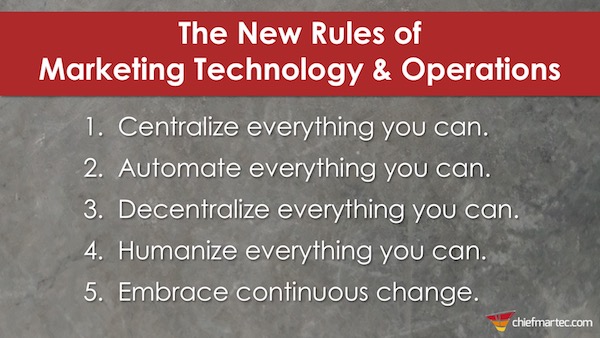

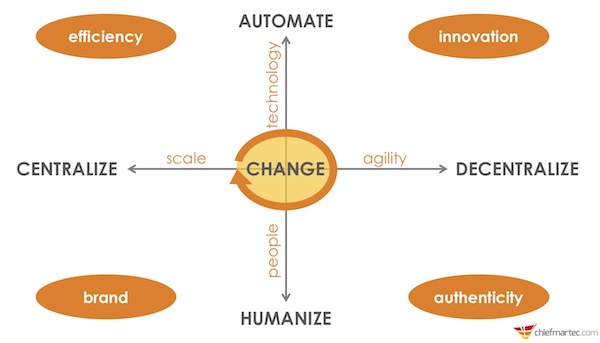



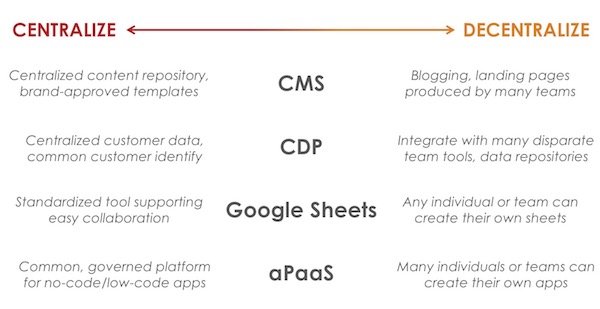




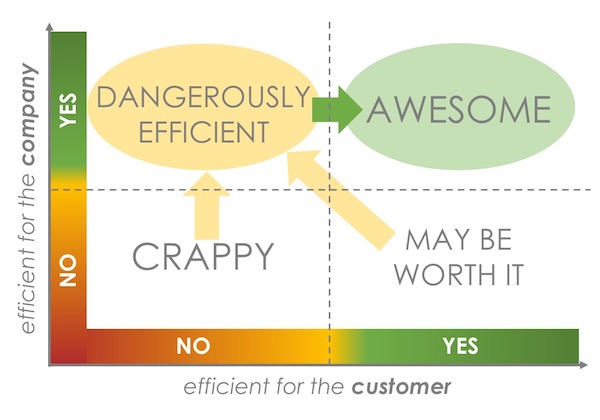
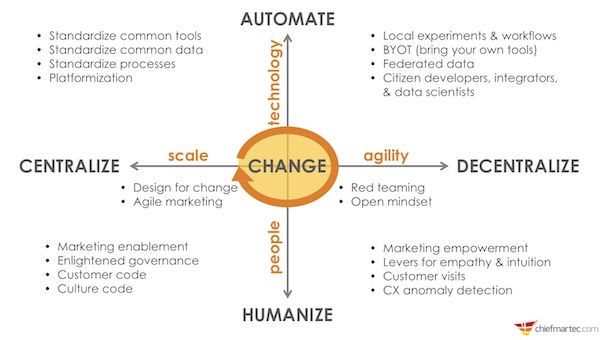

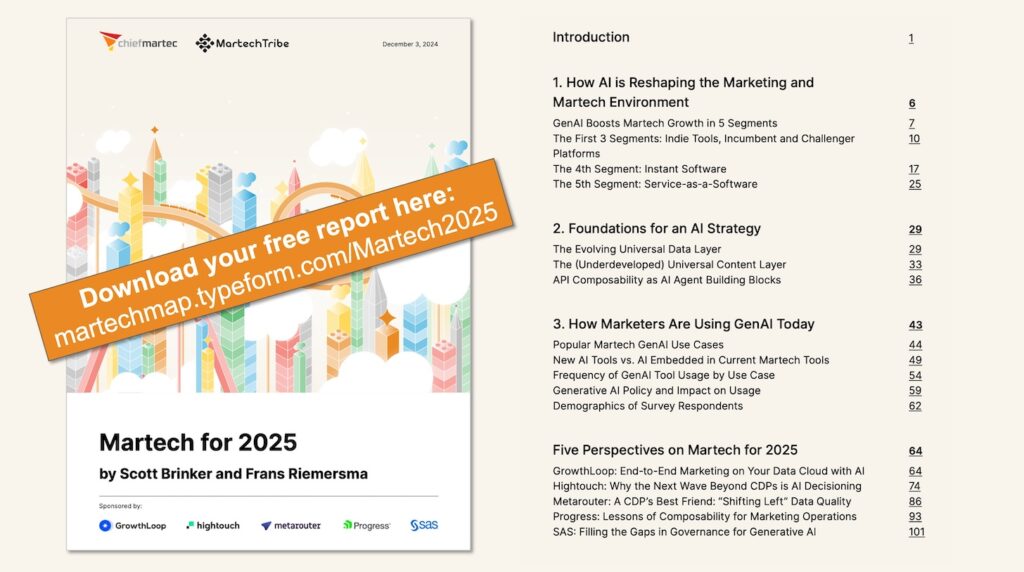

Hey Scott . . . so much fun to see you’re still using the term 10 years (I checked) after you gave my article credit for turning on your light bulb.
Many good wishes to you!
Brilliant insight of yours! Become quite the profession.
Hi Scott,
I was there in London when you presented this. Loved it!
My 5 cents on Centralization and Decentralization, if that is ok. The paradox is perhaps much smaller if we ask ourselves WHAT we advice marketers to centralize or decentralize? Technology, content, brand. compliance, decisions, data, budgets? All of the above? As a rule of thumb I like to think of centralizing the infrastructure, like a highway network, and decentralizing the way people want to use it to their benefit.
This infrastructure applies to technology, data, brand and content. In my mind centralization involves the decisions on WHAT to centralize, the “rules of engagement” or internal “SLAs” and communicating them clearly. This allows for an agile way of working. The Agile & Scrum frameworks do in fact the same.
Concerning WHAT to (de)centralize we can apply what the Microsoft stackie suggests: System of Record, Differentiation and Innovation. Why not work with Content of Record, Differentiation and Innovation? Or Data of Record, Differentiation and Innovation?
I’ve been doing some work with enterprise software sales teams on how to engage the MarTech team and I think this is a great model for how to align the differences between many tech and marketing mindsets. You can have your cake and eat it too.